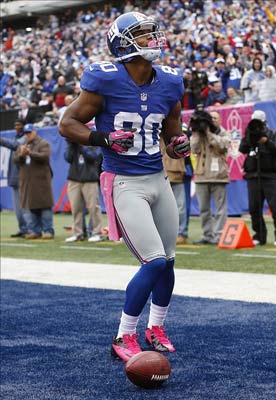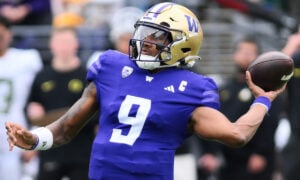Return on Your Investment: WRs
 One of the biggest keys to a successful dynasty team is making sure you acquire young prospects, either through the draft or through trades, and watch them mature into fantasy starters. In order to accomplish this, a savvy owner needs to be able to decide if a breakout season is coming or if it is time to cut bait and move on to the next prospect. This is the truly difficult part. How long do you wait on a quarterback before deciding that they aren’t worth it anymore? What about a running back or one of the other positions?
One of the biggest keys to a successful dynasty team is making sure you acquire young prospects, either through the draft or through trades, and watch them mature into fantasy starters. In order to accomplish this, a savvy owner needs to be able to decide if a breakout season is coming or if it is time to cut bait and move on to the next prospect. This is the truly difficult part. How long do you wait on a quarterback before deciding that they aren’t worth it anymore? What about a running back or one of the other positions?
This is the third in a four part series that will help to shed a bit more light on this subject – click here for the quarterbacks and here for the running backs.
In this article, we will examine the beginnings of the careers of several current wide receivers. We often hear of the third year breakout “rule,” but we will put this to the test. We will look at how many years it took for this group to earn the starting role, then how long it took before they reached the production level of a WR1 – this gives us another tool we can use to help decide when we should be expecting a breakout or be moving on from young wideouts as well as the 2012 rookie class.
For this study, the benchmark of WR1 level of production was determined by looking at the points for the 12th best wide receivers in PPR scoring over the last few years using the following scoring: six points for rushing/receiving touchdowns, one point for ten rushing/receiving yards, one point per reception, and -2 points for turnovers.
Wes Welker – Pure returner for his first year. Limited snaps at wide receiver in year two before playing a solid amount in year three pulling in 67 catches for 687 yards. He wasn’t a WR1 until year four when he became a Patriot.
Calvin Johnson – Started right away as a rookie, but only posted 48/756/4 in his first year. Broke out in year two and elite ever since.
Roddy White – Struggled to produce in his first two years with 29/446/3 and 30/506/0 lines. Since then he has always had at least 83/1150/6 each season. Never missed a game.
Victor Cruz – Inactive/injured during his rookie year. Broke out in year two and off to a very nice year three as well.
Percy Harvin – Kick returner first and a wide receiver second for his first two years. Produced WR1 numbers in year three once he was given enough snaps.
Steve Smith – Almost a pure kick returner in his rookie year – 54/872/3 line in year two. Broke out in year three.
Larry Fitzgerald – Strong rookie numbers with 58/780/8. Broke into WR1 numbers in year two and has been elite ever since, even with college level QBs.
Mike Wallace – Split time as a rookie between returning and receiving, producing 39/756/6. Broke out in year two.
Brandon Marshall – Limited role as rookie with 20/309/2. Produced WR1 numbers in his second year.
Hakeem Nicks – Part returner, part receiver as a rookie while posting 47/790/6. Broke out during his second year in the league.
Vincent Jackson – Essentially a redshirt year as a rookie. Limited action in year two with a 27/453/6 line. More playing time in year three, but only 41/623/3 line. Reached WR1 numbers in year four.
Greg Jennings – Split time between returns and receiving as a rookie with 45/632/3 line. On pace for WR1 numbers in year two, but slowed by injury. WR1 in year three.
AJ Green – Produced WR1 numbers as a rookie, which is obviously very rare.
Dwayne Bowe – Very good rookie year with 70/995/5. Produced WR1 numbers in year two.
Andre Johnson – Very solid rookie season with 66/976/4. Starting with year two he has produced WR1 numbers every year he’s been healthy.
Reggie Wayne – Limited snaps for the first two seasons with 27/345/0 and 49/716/4. Full time starter in his third season with 68/838/7 before breaking out in year four.
Let’s take a look at some of the trends that we see here:
- Only six of the wide receivers scored more than 150 fantasy points in PPR leagues from the receiver position during their rookie year. Most of those six were just barely over 150.
- Eleven of the sixteen wide receivers did see a significant amount of playing time as rookies, either as a second or third wide receiver or as a returner.
- Of the sixteen wideouts listed, only AJ Green produced WR1 numbers as a rookie.
- Eight of the sixteen wide receivers first produced WR1 numbers in their second season.
- Four of the sixteen didn’t reach WR1 numbers until year 3.
- Three of the sixteen took until their fourth year to post WR1 numbers.
Much like we have seen with the other positions, there is a fair amount of patience required with rookies and younger players. When only one of these receivers posts WR2 numbers or better as a rookie, you know you can’t expect much from any rookie receiver. Rookie seasons like those posted by AJ Green, Randy Moss or even Mike Williams are extremely rare and shouldn’t be expected no matter how good of a prospect they are. In short, it is going to take time for these young players to develop.
The big question is exactly how long.
Slightly over half of the sample was producing WR1 numbers in their second season. If we expand it out to the third season, we have over 80% of these wide outs producing at a WR1 level while all of them were producing by their fourth year. This doesn’t mean that wide receivers can’t produce late in their career if they haven’t done it by year four, just that it is very rare to see breakouts like the one we saw with Brandon Lloyd happen, though that still might be more mirage than a trend.
The idea of a third year breakout isn’t exactly true given that over half our sample broke out before then. However, that third year is basically the make or break year for wide receivers. It is the point where I would sell a receiver that isn’t producing at a WR1 level quite yet since only a small portion of our sample reached WR1 level after that third season. This means that third year receivers like Demaryius Thomas, Dez Bryant, Eric Decker, Brandon LaFell, and the rest of the 2010 wide receiver class need to put up WR1 numbers this year or their chances of doing it down the road are very slim. Fourth year receivers who haven’t produced WR1 numbers quite yet like Michael Crabtree and Darrius Heyward-Bey seem destined to never reach that level – that isn’t saying they aren’t worthwhile WR2s or WR3s, just that they are very unlikely to ever be more than that.
What’s the bottom line?
Don’t expect fantasy production from any rookie wideout. Regardless of who it is, very few become even a WR3 as a rookie, let alone produce WR1 numbers – that doesn’t happen until year two at the earliest. If someone isn’t producing WR1 numbers by midway into year three, they probably won’t be a WR1. If they haven’t done it by midway through year four, it is a virtual guarantee they won’t be.
- Final 2021 Pre-Draft Rookie Mock: Round Three - April 28, 2021
- Final 2021 Pre-Draft Rookie Mock: Round Two - April 26, 2021
- Final 2021 Pre-Draft Rookie Mock: Round One - April 25, 2021


































































